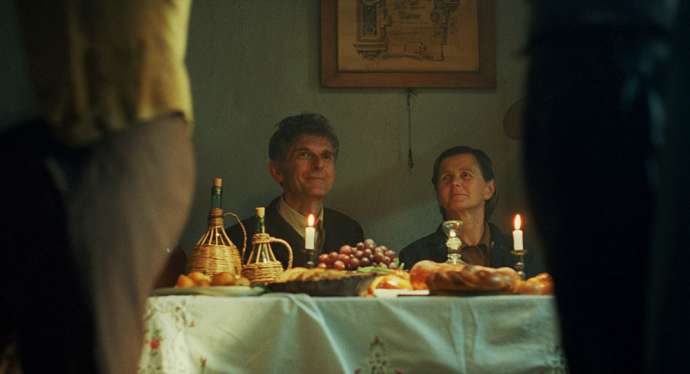STA, 21 November 2019 - Gregor Božič, whose feature debut Stories from the Chestnut Woods (Zgodbe iz kostanjevih gozdov) swept eleven awards at the Festival of Slovenian Film, has spoken to the STA about what is considered a ground-breaking achievement of Slovenia cinema. Božič dedicated the emigration-themed historical picture, shot on film, to neglected places and people.
The Slovenian-Italian co-production, going into general release in Slovenia after the end of the Ljubljana International Film Festival, was written by Božič and co-writer Marino Gumzi, who drew on Anton Chekhov's short stories and the post-WWII period in Benečija in the border area between Slovenia and Italy.
The up-and-coming director spoke passionately about the architecture and haunting remains of the region's abandoned villages.
"The most interesting thing about these villages was why they had been abandoned. It was all very mysterious," said Božič, whose family partly originates from the region's Brda area.
"I remember that local photographers used to go to these villages frequently and document all that had been left behind, by people who were literally leaving over night after 1954, trying to reach the US, Australia or other places through secret routes."
Božič had made trips to the region, also known as Terra delle Castagne or chestnut land, while researching old fruit varieties, but what stayed with him the most were the stories that locals shared with him in the company of a glass of wine.
Another thing was the specific atmosphere of the landscape, its "steep slopes, a river diving it, all of it in a fairly condensed location, it practically looked like a studio in nature to me".
Speaking about some of the incredible stories heard, he noted not all of the moments could be included in the film, "for instance one about how the brothers arrive home and the polenta is cooking on the stove, while the sister is simply gone over the border, for ever".
"And departing is also the main theme of the film, both of people to other places and in the sense of a final farewell, death. At the same time the film is an homage to neglected places and people living there."
While moreover speaking of references to the uncertain fate of these people looking for a better life, Božič said the makers of the film had also explored the parallels to today's reality and "the decomposition of the social fabric".
"For us, this was a story about a community that is pushed by economic circumstances to a point where culture is no longer important; what is important is counting money, which is something the carpenter Mario is doing in the film.
"Nothing good can come of a situation when people no longer talk to or hear each other. It is the circumstances that lead people to cynicism, bitterness. In the film it seems that such relations in the province are a personal affair, but the truth is that these are wider systemic issues."
Meanwhile, commenting on the film's chiaroscuro-inspired cinematography, Božič said it had all occurred very spontaneously, the cooperation with cinematographer Ferran Paredes Rubio also being the result of the director looking for somebody to separately look after the light while he would worry about composition.
"We made a very good team when it comes to achieving this light/dark effects. The scenographers and custom designers also deserve immense credit," he said.
Božič moreover defended the choice of 16-millimetre and 35-millimetre film as a method that in fact saves costs.
"I always say this to anyone telling me that shooting on film is expensive today. A lot of post-production work would have been needed had we attempted to achieve these effects with a digital camera, which of course means extra costs. This was definitely one of the best decisions we made."
Božič, who is likely to dedicate his next film "to much more modern topics", is presently working on a documentary about the perception of fruit today, about "the loss of an incredible wealth of tastes and forms that used to inspire farmers, artists and kings".






